Dear reader, I steal my headline from the inimitable Florence Welch, but it’s true, and equally, as Thoreau says, heaven is under our feet as well as above our heads. Our planet, this “blue dot” (Carl Sagan) is perfectly designed and perfectly in balance, if only we can see it and strive to live within the - perfectly calculated - limitations placed on us by the reality of finite resources.
Lets start with some wildflowers. Spring is definitely here, and well under way - at last. Recent weeks have seen an inundation of dandelions. This time last year was all about celandines, they were everywhere, golden hosts carpeting the verges and waysides, I’d never seen so many celandines in a season. This time, we are surrounded by dandelions, and, as per my last letter, I am glad, they are so generous and in sore need at this time of year, providing nourishment for our precious pollinators. I have been astounded to discover that there are 250 different types of dandelions recorded in the UK and Ireland - incredible!
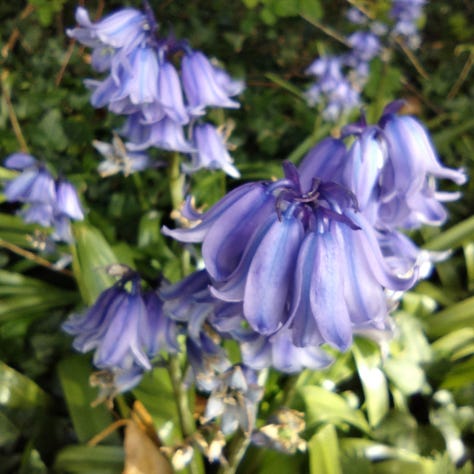


Having been surrounded by this sea of yellow, today, I wanted to spot something different. I set out with the intention of basking in the anticipated bath of blue - bluebells sprouting in eye catching patches all along the tip path, and providing a pleasing carpet in the woods around the pond. I’ve learned to be grateful for green alkanet too, and today it proved its worth. It was a bright, sunny day, warm enough with a chill bite remaining in the air. Lots of birdsong, but it wasn’t until I was in the big alkanet patch by the pond, admiring the variety of wild bees and hover flies - and what’s that I spot, an orange tip butterfly, where have you been?! - that I realised how little buzzing I had heard. The blue flowers hosted a wide variety of insects but far fewer than expected on the first warm day of spring. Let’s hope the #NoMowMay message reaches more people this year. Having said that, I was heartened to see as many wildflowers as I did. Let me share this weeks images:
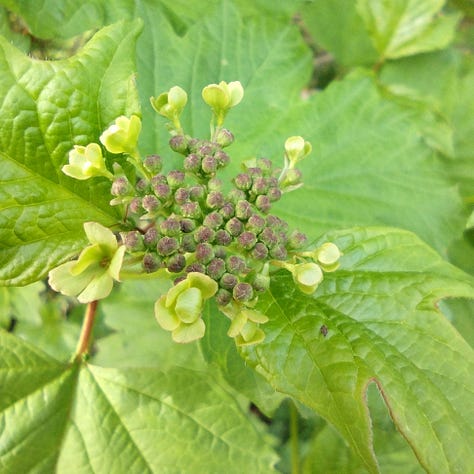
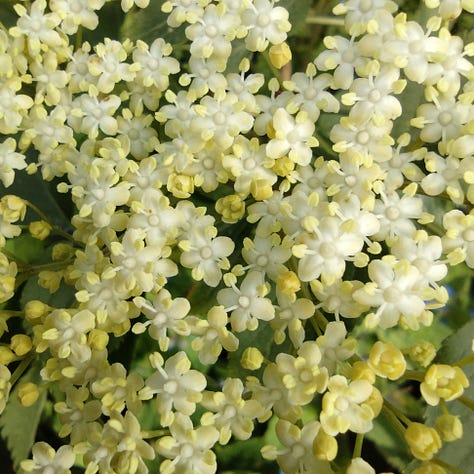
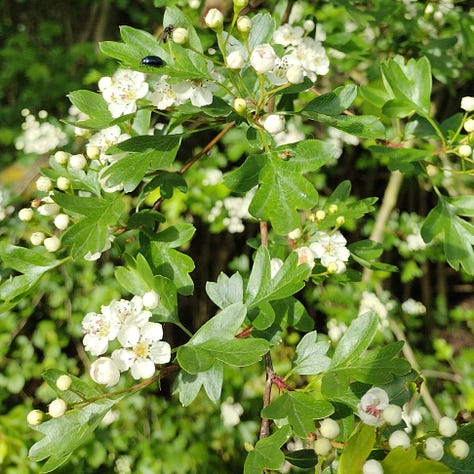
Guelder rose coming into flower, alongside hawthorn and elderflower, cherry and wild plum. I find these frothy white umbellifers so pleasing on the eye, the endless repetition of the tiny florets soothes and calms, a prescient reminder of natures future bounty. Many trees are wind pollinated but recent studies have revealed the importance of insects in this process. On a commercial scale, swarms of bees are move across country to pollinate almond groves. On a much smaller scale I recently learned that thrips - which I know as thunder flies - are a major pollinator of elderflowers. Everything has its place.
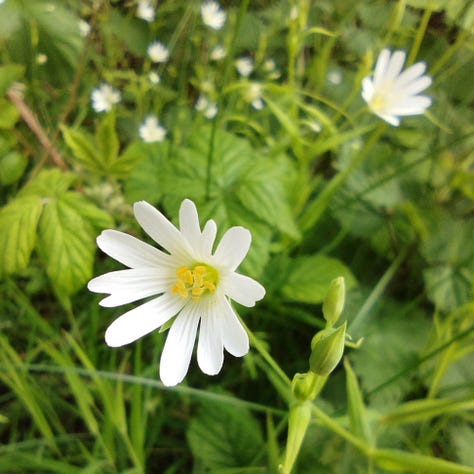
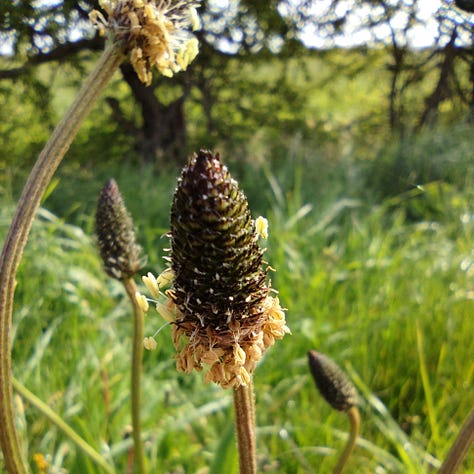
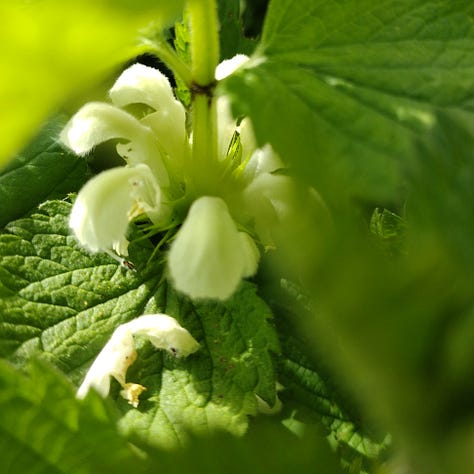
Elsewhere in the wayside I spotted lesser stitchwort with pleasingly uneven, lobed petals, ribwort plantain with snake like heads on sinuous stems and the white rings of hooded archangels clustered around the stems of white dead nettles, each flower concealing a little pair of the centipedes clogs, carefully hidden away from the naughty prankster fairies (look closely underneath the hood of the flower and you will indeed find what looks like a tiny pair of red clogs. You can find the story of the centipedes shoes here.)
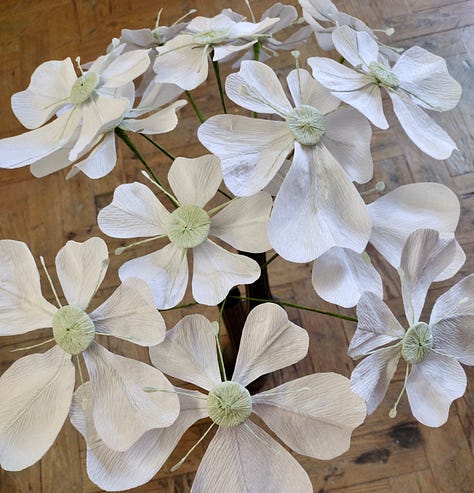
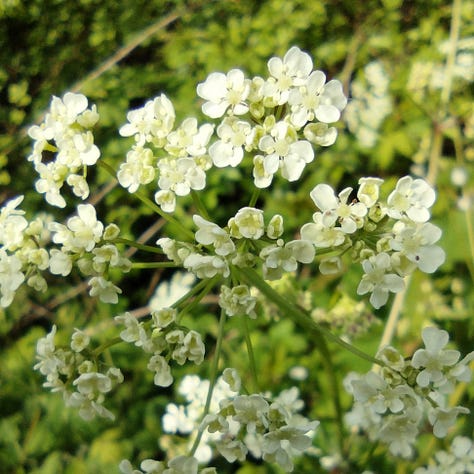
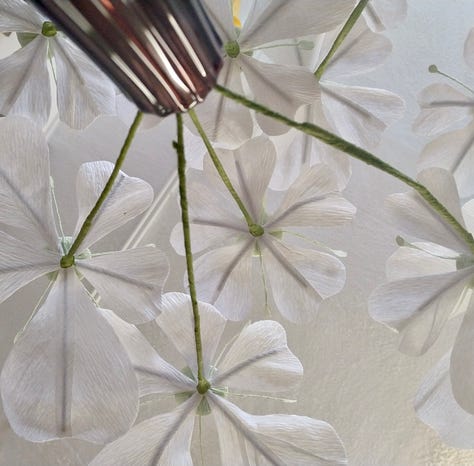
Work wise, I have been working an a big commission combining paper art, wildflowers and pollinators. Two days ago I was on a scaffold hanging a series of giant paper wildflowers as a canopy in the World Museum Atrium (Liverpool), adjacent to the anticipated Wolfgang Buttress Wild Bee exhibition. I create studies of the wildflowers which take my fancy ( yes, it’s hard to choose) so I had my own sketches and observations to work from when I created some sprigs of cow parsley flowers a couple of weeks ago, but it’s always a comfort to go back to source and compare the work to the real thing. Keep in mind that the larger florets of my Cow Parsley are approx 200-250mm across, compared to the life size 8mm…. When you play around with scale at this size, stylised or impressionistic representation is unavoidable but also tremendously enjoyable, from the POV of the creator!
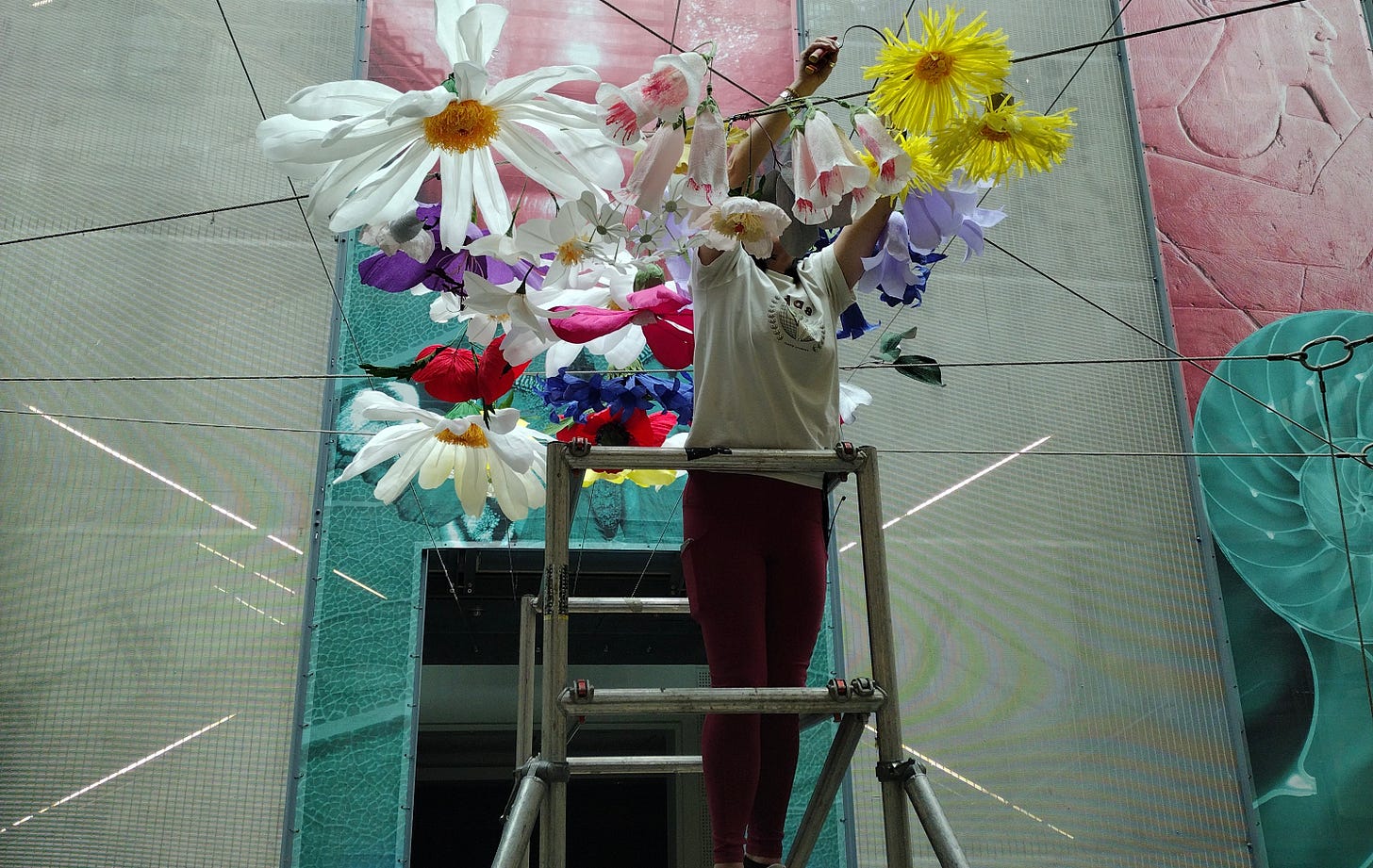
The exhibition Bees: A Story of Survival opens this weekend, exploring the epic tale of these incredible creatures and their essential relationship with the natural world through a visually stunning, immersive adventure. Maybe worth a special trip to Liverpool?!
Thanks for reading and following my meanderings along the Tip Path and musings on nature. With love as always, Ling
SUMMER PAPER FLOWER COURSE SCHEDULE
There are a couple of places left on both Paper Foxglove on Tuesday 14th May and Paper Hollyhock on Tuesday 21st May. Both classes last 5 hours to allow us to complete a full stem of these gorgeous stately flowers in one go. Please bring a packed lunch! Drinks, cake, snacks will of course be provided. Full price for each session £50, all tools and materials provided. Book online here.
The Paper Wildflower Course is back! This series of 2.5 hour day sessions starts on 18th June. There are six classes in total, each focusing on a different wildflower: Oxeye Daisies, Cornflowers, Harebells, Cyclamen, Dandelions and Sea Thistle, a varied selection. You can either book individual classes for £35 each or book the whole series and enjoy 15% off. The booking is set at half and half so if at any point you try to book and it's saying it's full, please get in touch as I may just need to reallocate sessions.
IN OTHER NEWS
Wirral Makefest is on 1st June 2024 at Birkenhead Library and The Williamson Gallery. A vintage bus will transport visitors between venues - I will be in the Library and hope to meet you there!
8-9 June is Wirral Open Studio Tour 2024 and I can’t wait to throw my studio doors open to visitors for the 4th year! I am launching some new craft packs for the occasion and will have new work on show - come along and “meet the maker”!
Press: you can find me in both Country Living UK this month (June issue) and with a longer format interview in Country Homes and Interiors (also June issue)!
Finally…. I am delighted to say I have been selected to participate in the Great Northern Contemporary Craft Fair - a 4 day craft extravaganza of the best regional artisans selected by a jury. 17 - 20 October at Victoria Baths, Manchester. Eek! See you there!


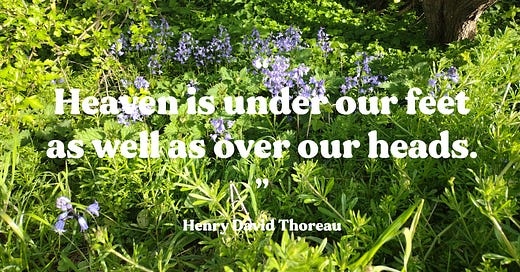



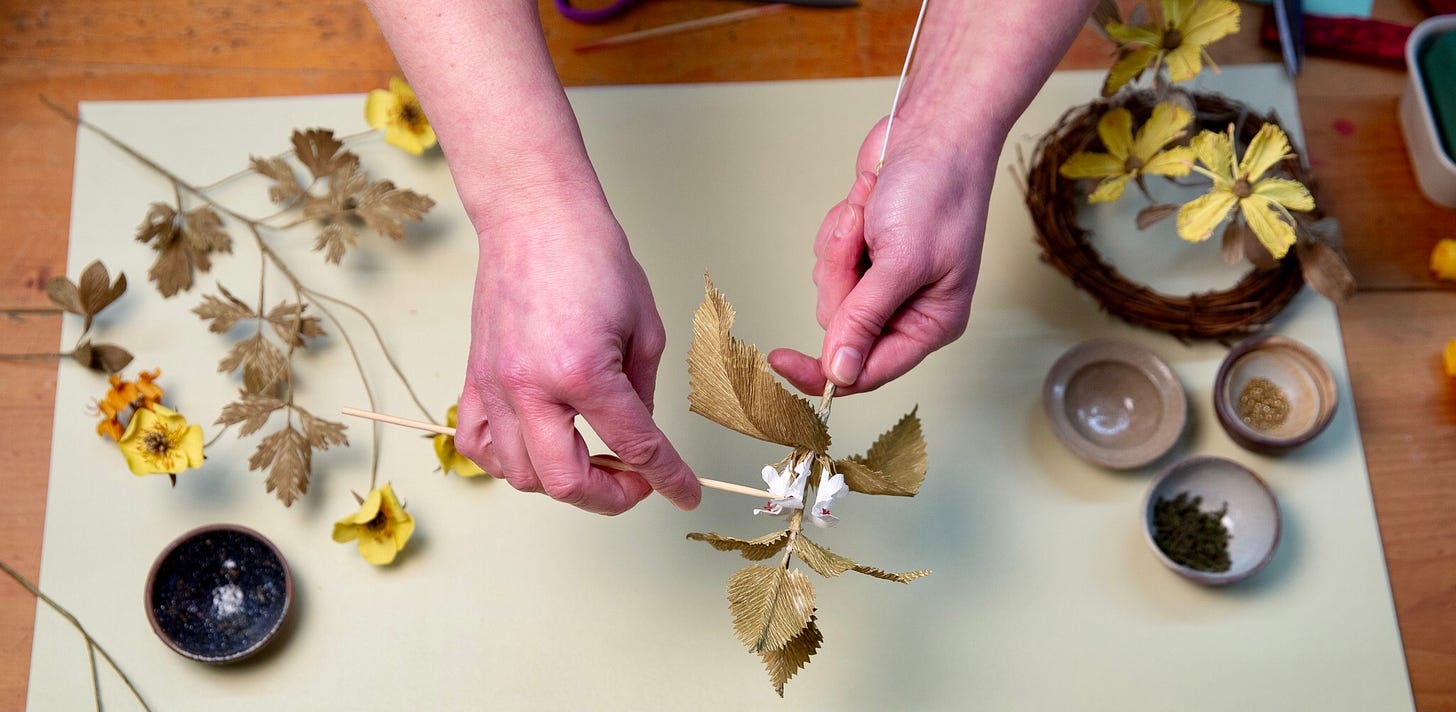

You write beautifully, Ling!
Even the things that we think of as ‘common’ are beautiful close up. Your installation looks wonderful.